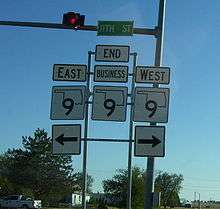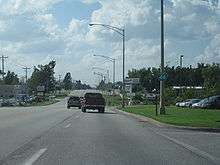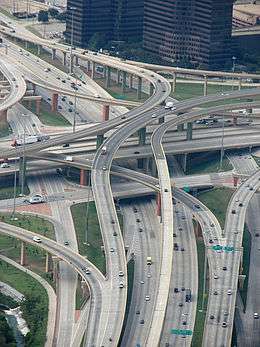Business route

A business route (occasionally city route) in the United States and Canada is a short special route connected to a parent numbered highway at its beginning, then routed through the central business district of a nearby city or town, and finally reconnecting with the same parent numbered highway again at its end.
Naming
Business routes always have the same number as the routes they parallel. For example, U.S. 1 Business is a loop off, and paralleling, U.S. Route 1, and Interstate 40 Business is a loop off, and paralleling, Interstate 40.
In some states, a business route is designated by adding the letter "B" after the number instead of placing a "Business" sign above it. For example, Arkansas signs US business route 71 as "US 71B". On some route shields and road signs, the word "business" is shortened to just "BUS". This abbreviation is rare and usually avoided to prevent confusion with bus routes.
Marking

.svg.png)

Signage of business routes varies, depending on the type of route they are derived from. Business routes paralleling U.S. and state highways usually have exactly the same shield shapes and nearly the same overall appearance as the routes they parallel, with a rectangular plate reading "BUSINESS" placed above the shield (either supplementing or replacing the directional plate, depending on the preference of the road agency). In order to better identify and differentiate alternate routes from the routes they parallel, some states such as Maryland are beginning to use green shields for business routes off U.S. highways. In addition, Maryland uses a green shield for business routes off state highways with the word "BUSINESS" in place of "MARYLAND" is used for a state route.[1]
Business Interstate highways use the same four-pointed shield design as regular Interstate highways, but substitute the normal red and blue layout with an all-green color scheme. Also, BUSINESS appears at the top of the shield instead of INTERSTATE, and either LOOP or SPUR may appear above the number. More information, and images of signage, is found here.
On maps, business routes are typically denoted with a standard marker containing the route number and the abbreviation "BUS" (e.g. "BUS 81" inside a U.S. route shield for Business US 81). For Interstate business routes, an indication of whether the route is a business loop or business spur may be included (such as printing "LOOP 44" inside an interstate marker). MDOT's official Michigan maps denote business Interstate routes with green shields similar to business interstate signage.
Maintenance
Business routes are maintained by different levels of government in different states. Many states incorporate business routes into their state-maintained highway systems; others, such as Indiana[2] and Wisconsin,[3] let local governments maintain them.
Formation

Business routes typically follow the original routing of the numbered route through a city or town, and were largely created during the era of the large-scale highway construction in the U.S. from the 1930s through to the 1970s. As U.S. Highways and Interstates were built, they would typically begin in the first phase of their development with the numbered route carrying traffic directly through the center of a given city or town. In the second phase of their development, bypasses would be constructed around the central business districts of the towns they had once passed directly through. As these bypasses were built, the original sections of these routes that had once passed directly through a given city or town would often be designated as “business routes”.
In many cases prior to the construction of such bypasses, local business would attempt to exert legal and/or legislative pressure for these bypasses to be routed so as to maximize access between their businesses and the proposed bypass loops, while federal planners might attempt to route such bypasses with less concern for the welfare of the businesses being bypassed.
City routes
City routes are most commonly found in the Midwest United States, although there are exceptions. These routes serve the same purpose as business routes, but they feature "CITY" signs instead of "BUSINESS" signs above or below route shields. Many of these city routes are being phased out in favor of the business route designation.
Another definition of a "city route" is similar to a county route, where a particular city forms its own highway system, usually of beltways. The city of Pittsburgh, Pennsylvania, for instance, has a colored belt road system. Officials in Charlotte, North Carolina created Charlotte Route 4, a loop of surface streets around uptown. A route in Pawtucket, Rhode Island known as the Downtown Circulator was created by the city to help travelers navigate the downtown area.
See also
- Alternate route
- Auxiliary route
- Bypass route
- List of business routes of the Interstate Highway System
- List of auxiliary U.S. Routes
References
- ↑ Signage for MD 5 Business along westbound MD 231. Retrieved on 2009-08-19.
- ↑ Indiana Code Title 8, Article 23, Chapter 6, Section 4
- ↑ Chapter 2, Section 4, Subject 19.1, "Traffic Guidelines Manual", Wisconsin Department of Transportation; transcription at Business Route Specifications, Wisconsin Highways website.
